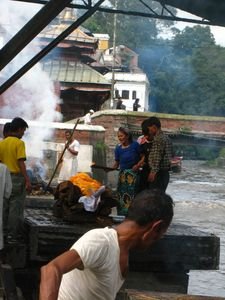Advertisement
Published: August 29th 2008

 funeral pyre
funeral pyre
a woman circles her relatives body with a torch before igniting it. On the way back to my guest house yesterday I wandered through the most important Hindu temple in Kathmandu- Pashupati. It was unbelievable, surreal and quite powerful. Soon after walking in I stood 20 feet from a ceremonial cremation and watched as a woman said some prayers and then helped to ignite the funeral pyre. Then I hang out with a ton of monkees that live there. In the hindu religion animals (well at least most) are holy because one day you might be reincarnated as them. makes sense. I saw several new bodies brought in on sheets and by ambulance.
This temple sits on the Bagmati river which drains into the Ganges in India. It really is much like a smaller version of Varanasi. There is a caste system in terms of where you can be cremated and a hospice home right over the river where people stay until they die. If your relatives die you must stay for 13 days in one of the shabby homes on the river. If you mother dies you must not eat milk for 1 year, no meat if it was your father.
At the temple and met a really nice Nepali

 Nepali kids
Nepali kids
On the steps across from where the cremations are occuring. These kids were jumping off the bridge into the water, and loved having their pictures takenkid (Neevan) who was eager to tell me all about the temple and the holy men (sandras?) that hung out. They live in caves just down the river and smoke hashish to enter trance states. I got to see one of there temples where the main holy man baba hangs out after Neevan showed me where it was.
Today at Tilganga I was able to be in the operating theatre (operating room) with a very well known ophthalmology here and saw something like 12 cataracts. Tomorrow i'll see some retinal surgery. Working at the hospital has been great and has exposed me to many of the contrasts that exist between our cultures and health care systems.
The Tilganga eye hospital is amazing, for it has nothing to do with the government. Instead it was founded by a Nepalese donor in 1994, and is sustained by revenue it generates, NGO's and private donations. About 30% of the cataract removals they do are done completely free. Otherwise it's a only $115 for everything if you can afford it, and less according to how much money you can give. The patients are so incredibly appreciative of the care they receive, and

 Holy men
Holy men
Sadhus (holy men) hang out by the water. They usually wave and then demand money- i suppose to support their drug habitincredibly respectful of the staff. Very few Nepali have any health insurance whatsoever, and if it weren't for this place many would be completely blind.
On a random note, the local time is 10 hours and 45 minutes ahead of eastern time. How does that make any sense?
Advertisement
Tot: 0.146s; Tpl: 0.02s; cc: 6; qc: 51; dbt: 0.0644s; 1; m:domysql w:travelblog (10.17.0.13); sld: 2;
; mem: 1.1mb

 funeral pyre
funeral pyre
 Nepali kids
Nepali kids
 Holy men
Holy men


